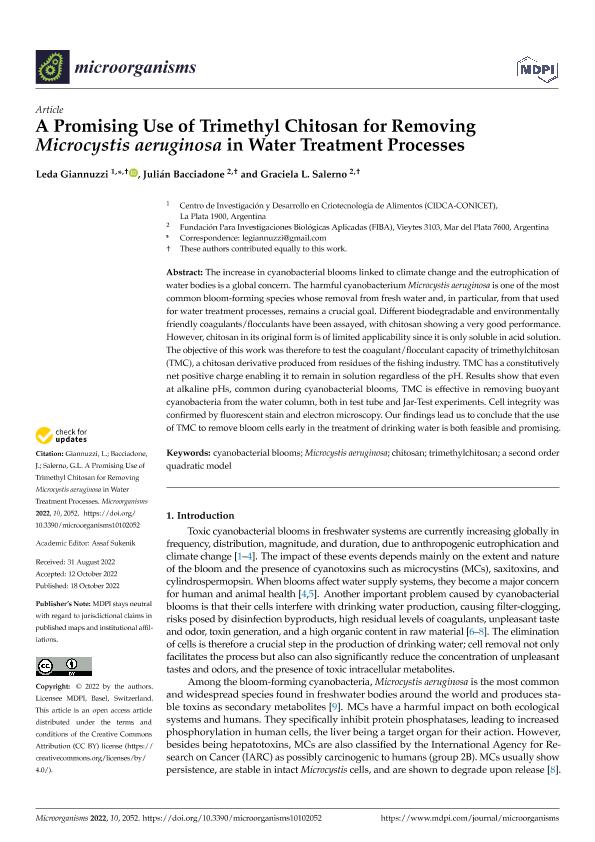Mostrar el registro sencillo del ítem
dc.contributor.author
Giannuzzi, Leda

dc.contributor.author
Bacciadone, Julián Andrés

dc.contributor.author
Salerno, Graciela Lidia

dc.date.available
2023-10-20T13:50:04Z
dc.date.issued
2022-10
dc.identifier.citation
Giannuzzi, Leda; Bacciadone, Julián Andrés; Salerno, Graciela Lidia; A Promising Use of Trimethyl Chitosan for Removing Microcystis aeruginosa in Water Treatment Processes; MDPI; Microorganisms; 10; 10; 10-2022; 1-15
dc.identifier.issn
2076-2607
dc.identifier.uri
http://hdl.handle.net/11336/215534
dc.description.abstract
The increase in cyanobacterial blooms linked to climate change and the eutrophication of water bodies is a global concern. The harmful cyanobacterium Microcystis aeruginosa is one of the most common bloom-forming species whose removal from fresh water and, in particular, from that used for water treatment processes, remains a crucial goal. Different biodegradable and environmentally friendly coagulants/flocculants have been assayed, with chitosan showing a very good performance. However, chitosan in its original form is of limited applicability since it is only soluble in acid solution. The objective of this work was therefore to test the coagulant/flocculant capacity of trimethylchitosan (TMC), a chitosan derivative produced from residues of the fishing industry. TMC has a constitutively net positive charge enabling it to remain in solution regardless of the pH. Results show that even at alkaline pHs, common during cyanobacterial blooms, TMC is effective in removing buoyant cyanobacteria from the water column, both in test tube and Jar-Test experiments. Cell integrity was confirmed by fluorescent stain and electron microscopy. Our findings lead us to conclude that the use of TMC to remove bloom cells early in the treatment of drinking water is both feasible and promising.
dc.format
application/pdf
dc.language.iso
eng
dc.publisher
MDPI
dc.rights
info:eu-repo/semantics/openAccess
dc.rights.uri
https://creativecommons.org/licenses/by/2.5/ar/
dc.subject
A SECOND ORDER QUADRATIC MODEL
dc.subject
CHITOSAN
dc.subject
CYANOBACTERIAL BLOOMS
dc.subject
MICROCYSTIS AERUGINOSA
dc.subject
TRIMETHYLCHITOSAN
dc.subject.classification
Biotecnología Medioambiental

dc.subject.classification
Biotecnología del Medio Ambiente

dc.subject.classification
INGENIERÍAS Y TECNOLOGÍAS

dc.title
A Promising Use of Trimethyl Chitosan for Removing Microcystis aeruginosa in Water Treatment Processes
dc.type
info:eu-repo/semantics/article
dc.type
info:ar-repo/semantics/artículo
dc.type
info:eu-repo/semantics/publishedVersion
dc.date.updated
2023-10-18T14:41:48Z
dc.journal.volume
10
dc.journal.number
10
dc.journal.pagination
1-15
dc.journal.pais
Suiza

dc.description.fil
Fil: Giannuzzi, Leda. Provincia de Buenos Aires. Gobernación. Comisión de Investigaciones Científicas. Centro de Investigación y Desarrollo en Criotecnología de Alimentos. Consejo Nacional de Investigaciones Científicas y Técnicas. Centro Científico Tecnológico Conicet - La Plata. Centro de Investigación y Desarrollo en Criotecnología de Alimentos. Universidad Nacional de La Plata. Facultad de Ciencias Exactas. Centro de Investigación y Desarrollo en Criotecnología de Alimentos; Argentina
dc.description.fil
Fil: Bacciadone, Julián Andrés. Fundación para Investigaciones Biológicas Aplicadas; Argentina
dc.description.fil
Fil: Salerno, Graciela Lidia. Fundación para Investigaciones Biológicas Aplicadas; Argentina. Consejo Nacional de Investigaciones Científicas y Técnicas. Centro Científico Tecnológico Conicet - Mar del Plata; Argentina
dc.journal.title
Microorganisms
dc.relation.alternativeid
info:eu-repo/semantics/altIdentifier/doi/http://dx.doi.org/10.3390/microorganisms10102052
Archivos asociados
